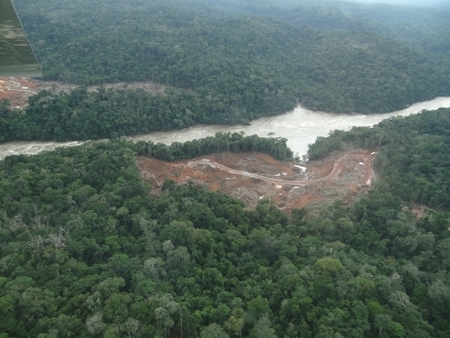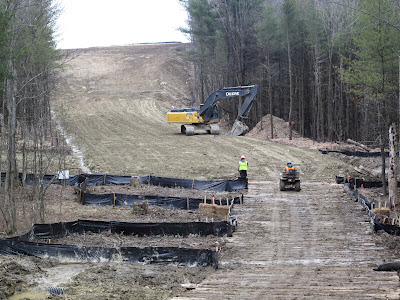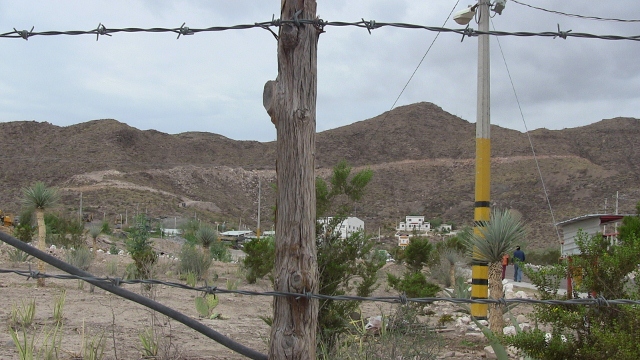
by Deep Green Resistance News Service | Aug 31, 2012 | Obstruction & Occupation, Toxification
By Everglades Earth First!
In the climax of the 2012 Republican National Convention, protestors with Earth First! have blocked access roads to TECO’s Big Bend coal plant on the eastern shore of Tampa Bay. The environmental action group is citing corporate influence in politics and ecological impacts of fossil fuel dependency as reasons for the disruption.
This year’s RNC was funded by an estimated $55 million in corporate pay-offs, with corporations including the Tampa based-TECO Energy, along with Chevron, Duke Energy and Exxon Mobil.
According to a report by Natural Resources Defense Council (NRDC) last year, Florida is among the dirtiest states in power plant pollution. NRDC found TECO’s Big Bend plant to be in the state’s, “top three most polluting smoke stacks.”
Earth First! activists chose this day for their protest in order to highlight Mitt Romney’s plan to expand what the group calls the “energy empire” which favors the interest of big donors in oil, gas and coal industries.
Romney’s top energy policy advisor is the wealthiest oilman in the country and according to data analyzed by the Center for Responsive Politics, Romney has already raised more from mining interests than Bush or McCain raised from these industries in their entire campaigns.
Locally, TECO’s Big Bend plant has a long history of pollution. Along with being declared Florida’s number one dirtiest power plant by Florida Consumer Action Network, they were also documented discharging waste into Cobia Bay in Apollo Beach in years past.
But that’s not all. TECO has been called one of the nation’s worst offenders when it comes to mountaintop removal coal mining. In coal mining regions of the Appalachian Mountains, TECO has ruined entire communities to maximize their profits. Kentucky coalfield resident Doug Justice worked in the coal mines for 22 years and said “I have never seen an outfit treat a community the way TECO Coal has done us.”
In response to the devastation from floods caused be TECO’s mining in 2002, Granville Burke of Letcher County, Kentucky, had this to say: “I wish TECO had never started mining above our home. Protection for families like ours is supposed to come from the state and federal regulatory agencies, but instead they look the other way as coal companies destroy entire communities for the sake of profit.”
“Dirty energy becomes dirty politics. We can’t afford to stand by and watch it anymore. We have to fight back.” Said Rachel Kijewski, an organizer with the Earth First! movement in Florida.
From Earth First! Newswire: https://earthfirstnews.wordpress.com/2012/08/31/earth-first-blockades-coal-plant-at-rnc-in-tampa/#more-10126
by Deep Green Resistance News Service | Aug 30, 2012 | Climate Change
By Press Association
A vast reservoir of the potent greenhouse gas methane may be locked beneath the Antarctic ice sheet, a study suggests.
Scientists say the gas could be released into the atmosphere if enough of the ice melts away, adding to global warming.
Research indicates that ancient deposits of organic matter may have been converted to methane by microbes living in low-oxygen conditions.
The organic material dates back to a period 35m years ago when the Antarctic was much warmer than it is today and teeming with life.
Study co-author Prof Slawek Tulaczyk, from the University of California at Santa Barbara, said: “Some of the organic material produced by this life became trapped in sediments, which then were cut off from the rest of the world when the ice sheet grew. Our modelling shows that over millions of years, microbes may have turned this old organic carbon into methane.”
Half the West Antarctic ice sheet and a quarter of the East Antarctic sheet lie on pre-glacial sedimentary basins containing around 21,000bn tonnes of carbon, said the scientists, writing in the journal Nature.
British co-author Prof Jemma Wadham, from the University of Bristol, said: “This is an immense amount of organic carbon, more than 10 times the size of carbon stocks in northern permafrost regions.
“Our laboratory experiments tell us that these sub-ice environments are also biologically active, meaning that this organic carbon is probably being metabolised into carbon dioxide and methane gas by microbes.”
The amount of frozen and free methane gas beneath the ice sheets could amount to 4bn tonnes, the researchers estimate.
Disappearing ice could free enough of the gas to have an impact on future global climate change, they believe.
“Our study highlights the need for continued scientific exploration of remote sub-ice environments in Antarctica because they may have far greater impact on Earth’s climate system than we have appreciated in the past,” said Prof Tulaczyk.
The Antarctic ice sheet covers the southern continent’s land mass and not the sea around it. Methane hydrates – a combination of frozen water ice and methane – are also found at the bottom of the oceans where they form as a result of cold temperatures and high pressures.
From The Guardian: http://www.guardian.co.uk/environment/2012/aug/29/antarctica-methane

by Deep Green Resistance News Service | Aug 26, 2012 | Biodiversity & Habitat Destruction, Colonialism & Conquest, Indigenous Autonomy, Lobbying
By Fabiola Ortiz / Inter Press Service
The Sete Quedas or “seven waterfalls” on the Teles Pires River, which runs through the Amazon rainforest states of Mato Grosso and Pará in central Brazil, are a spiritual oasis venerated by several indigenous groups.
But the 20-metre-high rocky falls are to be covered by a reservoir created by a hydroelectric dam that is to flood an area of 95 square km.
“It’s a sacred area, our creator and mother. And the ‘pajé’ (shaman) says it is where the fish lay their eggs,” João Kayabi, 52, told IPS by phone from the area. He is the chief of Kururuzinho village, home to 106 members of the Kayabi community, who speak a Tupí-Guaraní language.
For the Kayabi, the area around Sete Quedas must be left untouched, because it is the dwelling of a god who is responsible for the natural balance.
“It will be left underwater, and will only be a memory. We are trying to keep that from happening,” Kayabi said.
Sete Quedas is also sacred to two other indigenous communities: the Apiaká and the Mundurukú. For the latter, the falls are “the mother of fish” and the dwelling-place of their ancestors.
“The Mundurukú say the river is going to dry up, there will be a shortage of food, and the fish will vanish. I hope that isn’t so,” Kayabi said.
Studies on the biodiversity in that stretch of the river, carried out by Brazil’s Energy Research Company (EPE), which conducts research for the Ministry of Mines and Energy, have identified nearly 700 plant species and more than 200 species of fish, such as the spotted sorubim (Pseudoplatystoma corruscans) catfish, the common dolphinfish (Coryphaena hippurus), and the jau (Zungaro zungaro) catfish.
The Teles Pires has the reputation of being one of the world’s best rivers for fishing.
In the indigenous territory where João Kayabi’s village is located, nearly 300 people make a living from hunting, fishing and harvesting fruit.
“Up to now, our land has provided for us sufficiently. But we are concerned about what will happen in the future, and whether food will be scarce,” said the chief, a father of seven. “I’m worried about my children; I don’t know what will become of their lives.”
The Teles Pires plant will have a generating capacity of 1,820 MW. But the Companhia Hidrelétrica Teles Pires, the company that was granted the concession for building the dam, is fighting a judicial battle to be able to finish construction.
The project collides with the beliefs, customs and traditions of the Kayabi, Mundurukú and Apiaká Indians (a combined total of 12,000 people), said indigenous rights lawyer Juliana de Paula Batista, who advises native organisations in Brazil’s southwest Amazon region.
The case has been winding its way through the courts. In early August, a regional federal court ordered suspension of construction of the dam. But the attorney general’s office and Brazil’s environmental protection agency IBAMA appealed, and the suspension was lifted on Aug. 14.
“The natural resources that are indispensable for indigenous people to sustain their lifestyle and culture are being plundered,” Batista told IPS.
Early this year, the office of the public prosecutor brought a civil lawsuit to revoke the environmental license granted by IBAMA in August 2011 and bring construction to an immediate halt.
According to Batista, the environmental licensing process is flawed. “At no time has the magnitude of the impact on indigenous lands been fully understood.”
“The dam endangers fish stocks, the sacred site, water quality, rare and endemic species, vegetation in general, and hunting,” the lawyer said.
Although the tribes will not have to be relocated, they are afraid to remain in their villages “because in case of accidents, such as a break in the dam, the water would carry them away,” Batista said.
The Kayabi villages are only 50 km from the dam.
“There is no solution when it’s a government plan, we have no way to fight this,” Kayabi said. “The only way is to seek support and guidance. The dam will be built, and we are the ones who will be hurt by it, we could lose our rights.”
One of the irregularities noted by the office of the public prosecutor was the company’s failure to consult with the affected indigenous communities prior to the start of construction, as required by law. In March, work on the dam had already been suspended in response to the prosecutors’ request.
Read more from Inter Press Service: http://www.ipsnews.net/2012/08/hydropower-dam-to-flood-sacred-amazon-indigenous-site/

by Deep Green Resistance News Service | Aug 24, 2012 | Mining & Drilling, Repression at Home
By Alison K. Grass / AlterNet
Eminent domain, the government’s right to condemn (or take) private land for “public use,” has at times been a highly contentious topic because it can displace people from their homes to make way for construction of different projects, like highways or roads, civic buildings and other types of public infrastructure. However, what some may not realize is that several states have granted eminent domain authority to certain private entities, including oil and gas companies. These companies are using it as a tool to seize private land, which increases profits and benefits their wallets.
According to the U.S. Constitution’s Fifth Amendment, in order to pursue eminent domain, the land must be taken for “public use” and the private property owners must receive “just compensation.”
No person shall be . . . deprived of life, liberty, or property, without due process of law; nor shall private property be taken for public use, without just compensation.
Traditionally, the “public use” provision referred to projects like roads, schools, parks and other public facilities that could be directly used by all. However, the meaning of “public use” has been loosely interpreted in recent years.
The controversial Kelo v. City of New London (2005) is credited with broadening the interpretation of “public use.” In this case, the Supreme Court ruled in favor of New London, deciding that the city could take private property and give it to another private entity for “economic development.” The Court decided that this met the “public use” provision of the Fifth Amendment. But despite taking the land and spending millions of taxpayer dollars on the proposed project, the plan never came to fruition and nothing was constructed.
Now it seems that the oil and gas industry is capitalizing on this this precedent-setting case.
A University of Minnesota Law professor describes this trend: “in many natural resource–rich areas of the country, however, the knock on the door is less likely to come from a government official and much more likely to come from a mining, oil, or gas company representative.”
The state legislature of North Carolina recently legalized fracking. Yet, what some residents may not know is that North Carolina’s eminent domain law allows some private entities to take private property for certain uses. This includes oil and gas companies who have been given the right to condemn land and construct pipelines for natural gas transportation. As a supervising attorney at the Duke Environmental Law and Policy Clinic points out, there could be even bigger implications. “If private companies engaged in these activities are designated as ‘public enterprises,’ then they may be able to take private property for purposes far beyond that of laying pipelines.”
In July, the Pennsylvania Commonwealth Court ruled that provisions in Act 13, (which revised the Oil and Gas Act of 1984), aiming to prevent local zoning rules for gas drilling and fracking were unconstitutional. However the Court didn’t rule on the topic of eminent domain. This leaves open the possibility that oil and gas companies could pursue this as a method to take people’s land.
Meanwhile in Texas, TransCanada, the company that wants to build the Keystone XL Pipeline, is trying to grab private property from a small town, claiming they have eminent domain rights—and some residents are outraged.
The Kelo case broadened the interpretation of the “public use.” The city of New London took land from a private property owner so that they could give it to a private entity in the name of “economic development.” Unfortunately, oil and gas companies will now have this card to play when justifying land grabs.
From AlterNet: http://www.alternet.org/environment/how-some-states-are-giving-oil-and-gas-companies-right-take-your-land?paging=off
by Deep Green Resistance News Service | Aug 23, 2012 | Climate Change
By John Vidal / The Guardian
Arctic sea ice is set to reach its lowest ever recorded extent as early as this weekend, in “dramatic changes” signalling that man-made global warming is having a major impact on the polar region.
With the melt happening at an unprecedented rate of more than 100,000 sq km a day, and at least a week of further melt expected before it begins to reform ahead of the northern winter, satellites are expected to confirm the record – currently set in 2007 – within days.
“Unless something really unusual happens we will see the record broken in the next few days. It might happen this weekend, almost certainly next week,” Julienne Stroeve, a scientist at the US National Snow and Ice Data Centre in Boulder, Colorado, told the Guardian.
“In the last few days it has been losing 100,000 sq km a day, a record in itself for August. A storm has spread the ice pack out, opening up water, bringing up warmer water. Things are definitely changing quickly.”
Because ice thickness, volume, extent and area are all measured differently, it may be a week before there is unanimous agreement among the world’s cryologists (ice experts) that 2012 is a record year. Four out of the nine daily sea ice extent and area graphs kept by scientists in the US, Europe and Asia suggest that records have already been broken.
“The whole energy balance of the arctic is changing. There’s more heat up there. There’s been a change of climate and we are losing more seasonal ice. The rate of ice loss is faster than the models can capture [but] we can expect the arctic to be ice-free in summer by 2050,” said Stroeve.
“Only 15 years ago I didn’t expect to see such dramatic changes, no one did. The ice-free season is far longer now. Twenty years ago it was about a month. Now it’s three months. Temperatures last week in the arctic were 14C, which is pretty warm.”
Read more from The Guardian: http://www.guardian.co.uk/environment/2012/aug/23/arctic-sea-ice-record-low

by Deep Green Resistance News Service | Aug 22, 2012 | Mining & Drilling, Obstruction & Occupation, Worker Exploitation
By Paul Bocking / Waging Nonviolence
Civil disobedience has halted production at Mexico’s “top grade producer of silver.” Farmers of the La Sierrita village, a close knit community of about 50 families, located 40 minutes north of the city of Gomez Palacio, Durango, have shut down the La Platosa mine owned by Canadian firm Excellon Resources for over a month.
This comes in response to the company’s refusal to negotiate with the community over its requests for the preferential hiring of local people on whose land the company operates, as well as pay the rental rates for its use. Labor conditions within the underground mine where many local residents work is also an issue. Dozens of community members have maintained a nonviolent blockade of the one road into the mine, allowing only essential maintenance workers to pass, resulting in extraction grinding to a halt.
In recent years mining operations have drawn local protests from Peru to Tanzania and Papua New Guinea. Mexico is the site of several high profile struggles, nearly all involving Canadian companies. Communities are opposing the loss of their land and its contamination with toxins, including arsenic and cyanide, which are used in abundance in the extraction of gold.
Unlike many of these conflicts, the residents of La Sierrita have succeeded in inflicting a substantial economic cost to the company. As in the case of an effective strike, it is hoped that the continued shut down of its sole mining operation will eventually force Excellon to yield. Along with the community’s unified resolve to maintain the blockade, what distinguishes this struggle is that so far, it has succeeded in effectively disrupting the mine without triggering violent repression from the Mexican government or the company.
Many human rights activists are accustomed to campaigning against U.S.-based transnational corporations, which continue to dominate many sectors, but in the particularly violent, exploitative and dirty world of resource extraction, Canadian corporations are among the worst culprits. Since the mid-1990s, the Canadian-based mining sector has emerged to become the biggest in the world. The Toronto Stock Exchange is now the principal source of finance capital for mining operations. In 2010, Canadian mining companies held assets worth $129 billion internationally, with 90 percent owned by the 70 largest firms. Mexico is the second biggest country for Canadian overseas mining operations. With five mines, Goldcorp has the largest Canadian corporate presence in Mexico. Goldcorp also owns the infamous Marlin mine in Guatemala, where the company has been implicated in the deaths of human rights activists protesting its incursion into traditional indigenous territories.
Read more from Waging Nonviolence: http://wagingnonviolence.org/2012/08/no-silver-medal-mexican-farmers-battle-canadian-mine-for-control-of-their-land/




